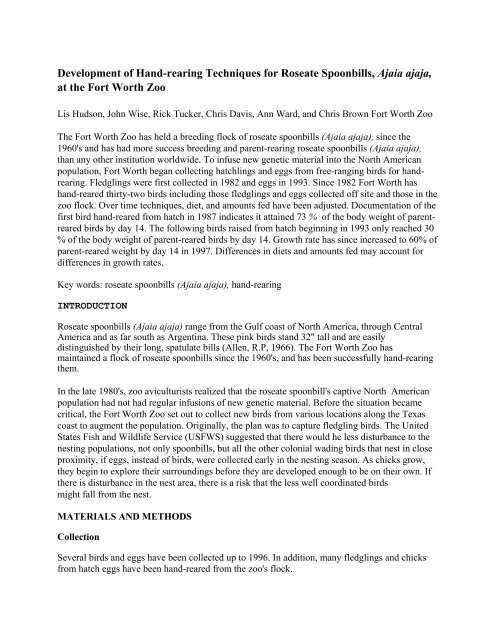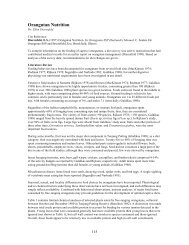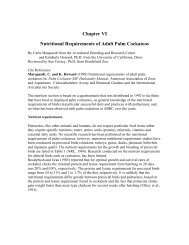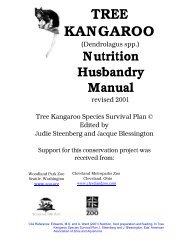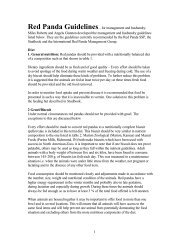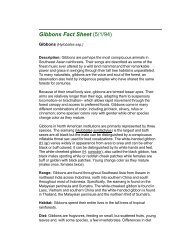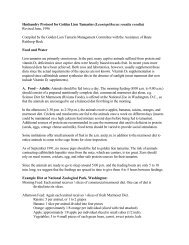Development of Hand-rearing Techniques for Roseate Spoonbills
Development of Hand-rearing Techniques for Roseate Spoonbills
Development of Hand-rearing Techniques for Roseate Spoonbills
Create successful ePaper yourself
Turn your PDF publications into a flip-book with our unique Google optimized e-Paper software.
<strong>Development</strong> <strong>of</strong> <strong>Hand</strong>-<strong>rearing</strong> <strong>Techniques</strong> <strong>for</strong> <strong>Roseate</strong> <strong>Spoonbills</strong>, Ajaia ajaja,<br />
at the Fort Worth Zoo<br />
Lis Hudson, John Wise, Rick Tucker, Chris Davis, Ann Ward, and Chris Brown Fort Worth Zoo<br />
The Fort Worth Zoo has held a breeding flock <strong>of</strong> roseate spoonbills (Ajaia ajaja), since the<br />
1960's and has had more success breeding and parent-<strong>rearing</strong> roseate spoonbills (Ajaia ajaja),<br />
than any other institution worldwide. To infuse new genetic material into the North American<br />
population, Fort Worth began collecting hatchlings and eggs from free-ranging birds <strong>for</strong> hand-<br />
<strong>rearing</strong>. Fledglings were first collected in 1982 and eggs in 1993. Since 1982 Fort Worth has<br />
hand-reared thirty-two birds including those fledglings and eggs collected <strong>of</strong>f site and those in the<br />
zoo flock. Over time techniques, diet, and amounts fed have been adjusted. Documentation <strong>of</strong> the<br />
first bird hand-reared from hatch in 1987 indicates it attained 73 % <strong>of</strong> the body weight <strong>of</strong> parentreared<br />
birds by day 14. The following birds raised from hatch beginning in 1993 only reached 30<br />
% <strong>of</strong> the body weight <strong>of</strong> parent-reared birds by day 14. Growth rate has since increased to 60% <strong>of</strong><br />
parent-reared weight by day 14 in 1997. Differences in diets and amounts fed may account <strong>for</strong><br />
differences in growth rates.<br />
Key words: roseate spoonbills (Ajaia ajaja), hand-<strong>rearing</strong><br />
INTRODUCTION<br />
<strong>Roseate</strong> spoonbills (Ajaia ajaja) range from the Gulf coast <strong>of</strong> North America, through Central<br />
America and as far south as Argentina. These pink birds stand 32" tall and are easily<br />
distinguished by their long, spatulate bills (Allen, R.P, 1966). The Fort Worth Zoo has<br />
maintained a flock <strong>of</strong> roseate spoonbills since the 1960's, and has been successfully hand-<strong>rearing</strong><br />
them.<br />
In the late 1980's, zoo aviculturists realized that the roseate spoonbill's captive North American<br />
population had not had regular infusions <strong>of</strong> new genetic material. Be<strong>for</strong>e the situation became<br />
critical, the Fort Worth Zoo set out to collect new birds from various locations along the Texas<br />
coast to augment the population. Originally, the plan was to capture fledgling birds. The United<br />
States Fish and Wildlife Service (USFWS) suggested that there would he less disturbance to the<br />
nesting populations, not only spoonbills, but all the other colonial wading birds that nest in close<br />
proximity, if eggs, instead <strong>of</strong> birds, were collected early in the nesting season. As chicks grow,<br />
they begin to explore their surroundings be<strong>for</strong>e they are developed enough to be on their own. If<br />
there is disturbance in the nest area, there is a risk that the less well coordinated birds<br />
might fall from the nest.<br />
MATERIALS AND METHODS<br />
Collection<br />
Several birds and eggs have been collected up to 1996. In addition, many fledglings and chicks<br />
from hatch eggs have been hand-reared from the zoo's flock.
Incubation and Brooding<br />
<strong>Roseate</strong> spoonbill eggs were incubated at 37.5° C and 84-86% humidity. Incubation was 27-28<br />
days. The chicks are blind and have only wispy bits <strong>of</strong> down when they hatch. They are kept in<br />
"nests," usually a margarine tub or pint fruit basket with a towel lining at a temperature close to<br />
37.6° C <strong>for</strong> the first few days. Initially, it was found that small brooders, 12" x 12" worked well<br />
<strong>for</strong> one or two chicks. Three or four chicks required a larger space. The temperature in the<br />
brooder is gradually decreased until the chicks are fully feathered. Once the need <strong>for</strong> additional<br />
heat is gone, the chicks "nests" can be put in 20 gallon aquaria.<br />
Nest sanitation<br />
For newly hatched chicks, a pint fruit basket lined with a washcloth or piece <strong>of</strong> towel worked<br />
well. The towel was changed following each feeding. Chicks soiled with feces were gently<br />
cleaned with a Q- Tip dipped in Warm water, as the top layer <strong>of</strong> skin can be easily removed.<br />
Routine swabbing <strong>of</strong> the inside <strong>of</strong> the bill prevented build up <strong>of</strong> food and fecal material which<br />
can lead to bacterial growth and bill de<strong>for</strong>mities..<br />
As the chicks grew, increasingly larger plastic bowls or sweater boxes lined with towels made<br />
sturdy, easy to disinfect nests. Fresh, leafy twigs were added to the nests as the chicks became<br />
more active, to develop foot and leg muscles. Additionally, feces fell through the leaves leaving<br />
less to stick to the chicks. By this time, chicks no longer needed towels under them <strong>for</strong> warmth,<br />
and cleaning time was further decreased, by lining the box with newspaper, so that excrement and<br />
plant material could be rolled up and tossed out. The best results were obtained with bamboo and<br />
Texas privet as the nest substrate.<br />
Feeding<br />
Adult spoonbills feed their chicks by regurgitation. To duplicate this, a liquid diet was fed with a<br />
syringe and catheter tube. The size <strong>of</strong> the syringe was determined by the amount the chicks were<br />
consuming. For the first few feedings, a 3 cc syringe was used. Syringe size was gradually<br />
increased to 6cc, 12 cc and 20 cc syringe capacity .<br />
The catheter tubing diameter was determined by the size <strong>of</strong> the syringe, not by the size <strong>of</strong> the<br />
chick. The tube was no more than 1 1/2 inches in length. Once a feeding routine was established,<br />
the chick would readily open its mouth to take the tube. Care was taken to avoid putting the<br />
<strong>for</strong>mula in the trachea rather than the esophagus. The chicks moved away from the tube when<br />
they were full.<br />
Formula<br />
Detailed records were not available on hand-<strong>rearing</strong> prior to 1993. In, 1993 available <strong>for</strong>mula<br />
in<strong>for</strong>mation was further developed by the bird department staff (Tale 1 ). At this time detailed<br />
records began to be kept. For the first two to three days, the <strong>for</strong>mula was diluted 1: 1
with Pedialyte (Ross Laboratories, Division <strong>of</strong> Abbott Laboratories, P.O. Box 1317, Columbus,<br />
OH 43216): and warmed to 38.9 to 40.6°C. During the first feeding chicks took no more than<br />
1.5 cc. Five feedings (one every four hours) beginning at 8:00 am and ending between 11 pm and<br />
midnight were initially <strong>of</strong>fered. The commissary prepared the <strong>for</strong>mula in large hatches and froze<br />
it in smaller packages. Formula was thawed fresh <strong>for</strong> each feeding. Feeding tools were stored in a<br />
disinfectant between feedings.<br />
By day four, the volume was up to 4 ccs per feeding and was diluted with distilled water at a ratio<br />
<strong>of</strong> 2:1. The chicks have developed a good feeding response by day 4, sitting up on the hocks,<br />
head and neck extended up, head bobbing and vocalizations <strong>of</strong> a high shrill trill.<br />
Days 7-9, the <strong>for</strong>mula was diluted 3:1 with water and by day 10, full strength <strong>for</strong>mula was fed.<br />
At approximately day 18, chicks were receiving four <strong>for</strong>mula feedings <strong>of</strong> 60 cc daily.<br />
Additionally, small pieces <strong>of</strong> Birds <strong>of</strong> Prey diet (Animal Spectrum Inc., P.O. Box 721, North<br />
Platte, NE 69103-0721) mixed with Mazuri flamingo pellets (Purina Mills, Inc., 1401 Hanley<br />
Road, St Louis, MO 63144) were given. Around Day 30, the amount <strong>of</strong> <strong>for</strong>mula fed was<br />
decreased to encourage consumption <strong>of</strong> solid food. Balls <strong>of</strong> the meat mixture were <strong>of</strong>fered after<br />
each <strong>for</strong>mula feeding. By Day 35 only solid food was <strong>of</strong>fered.<br />
In 1995, parent-reared chicks were weighed to quantify differences in growth rates. Four chicks<br />
were selected, based on nest site. Nest sites on the periphery <strong>of</strong> the colony were preferable as<br />
there would be less disturbance to the flock to have a keeper climbing up and removing chick<br />
each day. As with the hand-reared chicks, weights were taken first thing in the morning.<br />
RESULTS<br />
Incubation and Brooding<br />
Hatch weights range from 37 to 47 grams. Behavior was the best guide <strong>for</strong> temperature reduction.<br />
When over-heated, chicks would pant, drop their wings, and droop their heads over the sides <strong>of</strong><br />
the nest. Cold chicks would huddle together and their skin color would become paler. Humidity<br />
and air flow are important considerations since chicks dehydrate quickly if humidity is too low<br />
(below 82-86% ) or if the "nest" is in the path <strong>of</strong> moving air from the brooder fan. It was<br />
determined that the combination <strong>of</strong> a baffle and a tray <strong>of</strong> water kept the chicks well hydrated.<br />
Nest sanitation<br />
Cleanliness is important <strong>for</strong> feather growth as well as <strong>for</strong> warmth. It was difficult to ,<br />
and maintain sanitary conditions. Chicks defecated over the side <strong>of</strong> the nest quickly developing<br />
quite a range. Initially, however, all the waste ends up in the nest and it was necessary to change<br />
the nest towel following each feeding.<br />
Feeding<br />
At even the first feeding, the chick will actively swallow <strong>for</strong>mula. Care must be taken not to over<br />
feed the chick. Although they may continue to call and bob their heads, it will not be easy to<br />
insert the feeding tube. After feeding, the youngest chicks went straight to sleep, while older
chicks will stay up <strong>for</strong> a while and were at their noisiest. Each chick generally defecated at<br />
feeding time.<br />
Growth<br />
Based on available data, hand-reared birds never reached weights comparable to parent-reared<br />
birds at 7 and 14 days <strong>of</strong> age (Figure 1). Data points include the average <strong>of</strong> all birds hand-reared<br />
during that year. The first fledgling collected in 1982 was approximately 14 days old. The first<br />
chick hand-reared from day one <strong>of</strong> the 1987 hatch achieved the highest weight comparable<br />
to adult-reared chicks or 73 % <strong>of</strong> their weight. A chick hand-reared from approximately 6 days <strong>of</strong><br />
age in 1988 did equally well, achieving 76% <strong>of</strong> adult-reared chick weight by day 14.<br />
Birds were not hand-reared again until 1993. These birds these chicks achieved only 30 % <strong>of</strong> the<br />
parent reared chick weights at 7 and 14 days <strong>of</strong> age. Growth rates improved over time with the<br />
birds hand-reared in 1997 reaching 60% <strong>of</strong> the parent reared weights at 7 and 14 days.<br />
By 1997, hand-reared birds were consuming as much 100 % <strong>of</strong> their body weight per day in<br />
<strong>for</strong>mula during these first 14 days. The 1993 birds had only been consuming 40 % <strong>of</strong> their body<br />
weight in <strong>for</strong>mula daily during this same time. Solids including, lake smelt, Bird <strong>of</strong> Prey<br />
diet, and Flamingo pellets were not introduced to the 1997 birds until 18 days <strong>of</strong> age. At 30 days<br />
<strong>of</strong> age these birds were still consuming 30- 40 % <strong>of</strong> their body weight in <strong>for</strong>mula daily. Solid<br />
food consumption at this time was approximately 6 % <strong>of</strong> body weight daily. It is possible the<br />
quicker incorporation <strong>of</strong> a solid diet into the <strong>rearing</strong> <strong>of</strong> the 1982, 1987, and 1988 birds accounts<br />
<strong>for</strong> the differences in body weights. The solid food items are higher in energy content than the<br />
liquid diet (Table 3.)<br />
Two <strong>of</strong> the four chicks died, one on day 3 and one on day 4. Cause <strong>of</strong> death was not clear. The<br />
two that survived were weighed until day 15 (Figure 1).<br />
DISCUSSION<br />
Collection<br />
<strong>Spoonbills</strong> typically lay 3-4 eggs. No more than 50% <strong>of</strong> eggs or chicks from anyone nest were<br />
taken during the collection process and usually only one was taken per nest regardless <strong>of</strong> the total<br />
number. Each year, in conjunction with the USFWS, the zoo collected from a different area along<br />
the Texas coast in hopes <strong>of</strong> getting specimens from distinctly different gene pools. A genetics<br />
study in progress with the University <strong>of</strong> North Texas will eventually determine if this method<br />
was successful.<br />
Feeding<br />
It is easier to feed using several 20 cc syringes than to struggle with a 60 cc syringe when the<br />
chicks are able to consume 60 ccs or more per feeding. It requires one hand to steady the chick.<br />
The chicks have developed a good feeding response by day 4, sitting up on the hocks, head and<br />
neck extended up, head bobbing and vocalizations <strong>of</strong> a high shrill triill.
The plunger may be difficult to work on the 60 cc syringe depending on the size <strong>of</strong> the feeder's<br />
hands. It is important to closely monitor the rate at which the <strong>for</strong>mula is fed. If <strong>for</strong>mula goes in<br />
too quickly, it will come right back out. The chick will let the feeder know when it is full. The<br />
neck can be observed swelling as the <strong>for</strong>mula goes down.<br />
Sanitation<br />
It is important to clean the bill. Because the chicks <strong>of</strong>ten sleep with the bill on the edge <strong>of</strong> the<br />
nest, feces can adhere to the bill and actually cause abnormal growth. A period as short as<br />
overnight is enough to cause a problem build-up.<br />
Growth<br />
During the first year <strong>of</strong> hand-<strong>rearing</strong>, growth <strong>of</strong> the chicks was limited to 10% <strong>of</strong> the total body<br />
weight daily (Figure I). The first year chicks rarely seemed satisfied at the end <strong>of</strong> a feeding.<br />
Based on observations <strong>of</strong> parent-reared chicks in the collection, the hand-reared chicks were<br />
nearly half the size <strong>of</strong> those parent-reared. <strong>Hand</strong>-reared chicks were weaned at the proper age<br />
(approximately 40 days) but took a couple <strong>of</strong> months to catch up in terms <strong>of</strong> size. The second<br />
year, chicks were fed until they indicated they had enough. The weight gains were much more<br />
rapid, although they were still not at the rate <strong>of</strong> the parent-reared birds (Figure 1). During the<br />
following years, amount <strong>of</strong> <strong>for</strong>mula <strong>of</strong>fered continued to be increased.<br />
While a more concentrated <strong>for</strong>mula may facilitate greater weight gains, increasing the<br />
concentration <strong>of</strong> the current <strong>for</strong>mula to full strength in less than 10 days resulted in difficulties in<br />
keeping the birds hydrated. An African spoonbill (Platalea alba), hand-reared at the North<br />
Carolina Zoological Park, was introduced to solid food (Bird <strong>of</strong> Prey diet and Flamingo Fancier)<br />
at 10 days <strong>of</strong> age and achieved weight gains similar to parent-reared birds through 28 days <strong>of</strong> age<br />
(Reininger, 1997). The African spoonbill was fed chopped pink rats at 70 %, <strong>of</strong> body weight<br />
daily up until the adult diet began to be incorporated at day 10. This bird was completely on the<br />
adult diet by day 15 consuming 50 % <strong>of</strong> its body weight per day. The hand-reared roseate<br />
spoonbill did not begin consuming the adult diet until days 18 to 21. At 14 days <strong>of</strong> age the 1997<br />
hand-reared roseate spoonbills were 60 % <strong>of</strong> the body weight <strong>of</strong> the parent-reared bird; and were<br />
still consuming <strong>for</strong>mula at a rate <strong>of</strong> 80 % <strong>of</strong> body weight per day. The hand-reared birds did not<br />
begin consuming the adult diet until days 18 to 21.<br />
The 1997 birds were still partially hand fed at 80 days <strong>of</strong> age. Until this year, chicks were always<br />
feeding entirely on their own by day 40. In 1997, fish was simply not <strong>of</strong>fered to the chicks during<br />
the weaning. Fish was eliminated from the diet <strong>of</strong> the adult spoonbills earlier in the year. Rather<br />
than accustom the chicks to fish and remove it from the diet, it was not <strong>of</strong>fered. It is not clear<br />
how fish may play a role in the extended time taken <strong>for</strong> the 1997 birds to eat on their own<br />
compared to birds from previous years.<br />
Regardless <strong>of</strong> growth rate during hand-<strong>rearing</strong>, all birds hand-reared at Fort Worth were able to<br />
attain adult weights though this process took longer than that in parent-reared birds.<br />
Compared to the hand-reared chicks problems encountered with parent-reared chicks in the zoo<br />
flock were: 1) mortality was higher in the flock situation; and 2) the chicks were very mobile and
impossible to weigh after about day 15. It is not clear why mortality would be higher among<br />
chicks in the flock situation. Those chicks hand-reared we kept in a controlled environment thus<br />
avoiding weather changes or temperature extremes. It was much easier to observe the handreared<br />
chicks <strong>for</strong> signs <strong>of</strong> weakness.<br />
CONCLUSIONS<br />
The Fort Worth Zoo has successfully hand-reared 32 spoonbills over the past 15 years. Diet<br />
modification including feeding volumes up to 100 % <strong>of</strong> a chick's weight daily in <strong>for</strong>mula has<br />
facilitated increased growth rates. <strong>Hand</strong>-reared chicks do not attain weight gains comparable to<br />
parent-reared chicks. However, growth rates over time have increased to 60 % <strong>of</strong> parent-reared<br />
weight by day 14. All hand-reared birds reach adult size though at a slower rate than parentreared<br />
birds.<br />
To facilitate increased genetic diversity in the captive collection <strong>of</strong> roseate spoonbills in North<br />
America, the zoo has collected eggs and fledglings from free-ranging birds over the part 15 years.<br />
A successful hand-<strong>rearing</strong> protocol has facilitated the incorporation <strong>of</strong> new individuals. A genetic<br />
study in progress will help determine if these collecting expeditions have been successful with<br />
regard to genetic background.<br />
REFERENCES<br />
Porter, R.A. THE ROSEATE SPOONBILL. Dover Publications, Inc., New York. 10014. 1966<br />
Reininger, K.. North Carolina Zoological Park, 4401 Zoo Parkway, Asheboro, NC 27203.<br />
Personal communication. October 1997.<br />
Table 1. Fort Worth Zoo spoonbill hand <strong>rearing</strong> <strong>for</strong>mula, ingredients by percent weight on an as<br />
fed basis.<br />
Ingredient Precent <strong>of</strong> the diet<br />
Lake smelt 11.10 %<br />
Flamingo diet-1 11.10 %<br />
Bird <strong>of</strong> Prey-2 11.10 %<br />
Shrimpmeal 2.22 %<br />
High protein dog chow-3 1.11 %<br />
Vionate-4 0.30 %<br />
Calcuim carbonate 0.15 %<br />
Water 62.92 %<br />
1-Flamingo diet- Mazuri flamingo diet, Purina Mills, Inc. 1401 Hanley Road, St. Louis, Mo<br />
63144<br />
2-Bird <strong>of</strong> Prey diet-Animal Spectrum, Inc., P.O. Box 721, North Platte, NE 69103-0721<br />
3-High protein dog chow-Ralston Purina, Inc., St.Louis, MO 63164<br />
Vionate-ARC Laborities, 4280 N.E. Expressway, Atlanta, GA 30340
Table 2. Nutrient content <strong>of</strong> Fort Worth Spoonbill <strong>for</strong>mula on a fed basis.<br />
Nutrient Level in the Diet<br />
Dry Matter 20.2 %<br />
Gross energy 0.96 Kcals/g<br />
Crude protein 8.28%<br />
Fat 2.02 %<br />
Calcuim 0.77 %<br />
Phosphorus 0.35 %<br />
Table 3. The gross energy content <strong>of</strong> some foods fed to spoon bills on an as fed basis<br />
Food item Dry Matter Gross energy<br />
Fort Worth <strong>for</strong>mula 20.2 % 0.96 Kcals/g<br />
Lake smelt 20.1 % 0.98 Kcals/g<br />
Bird <strong>of</strong> Prey diet-1 37.8 % 2.14 Kcals/g<br />
Flamingo pellets-2 95.7 % 4.23 Kcals/g<br />
1-Flamingo diet- Mazuri flamingo diet, Purina Mills, Inc. 1401 Hanley Road, St. Louis, Mo<br />
63144<br />
2-Bird <strong>of</strong> Prey diet-Animal Spectrum, Inc., P.O. Box 721, North Platte, NE 69103-0721


